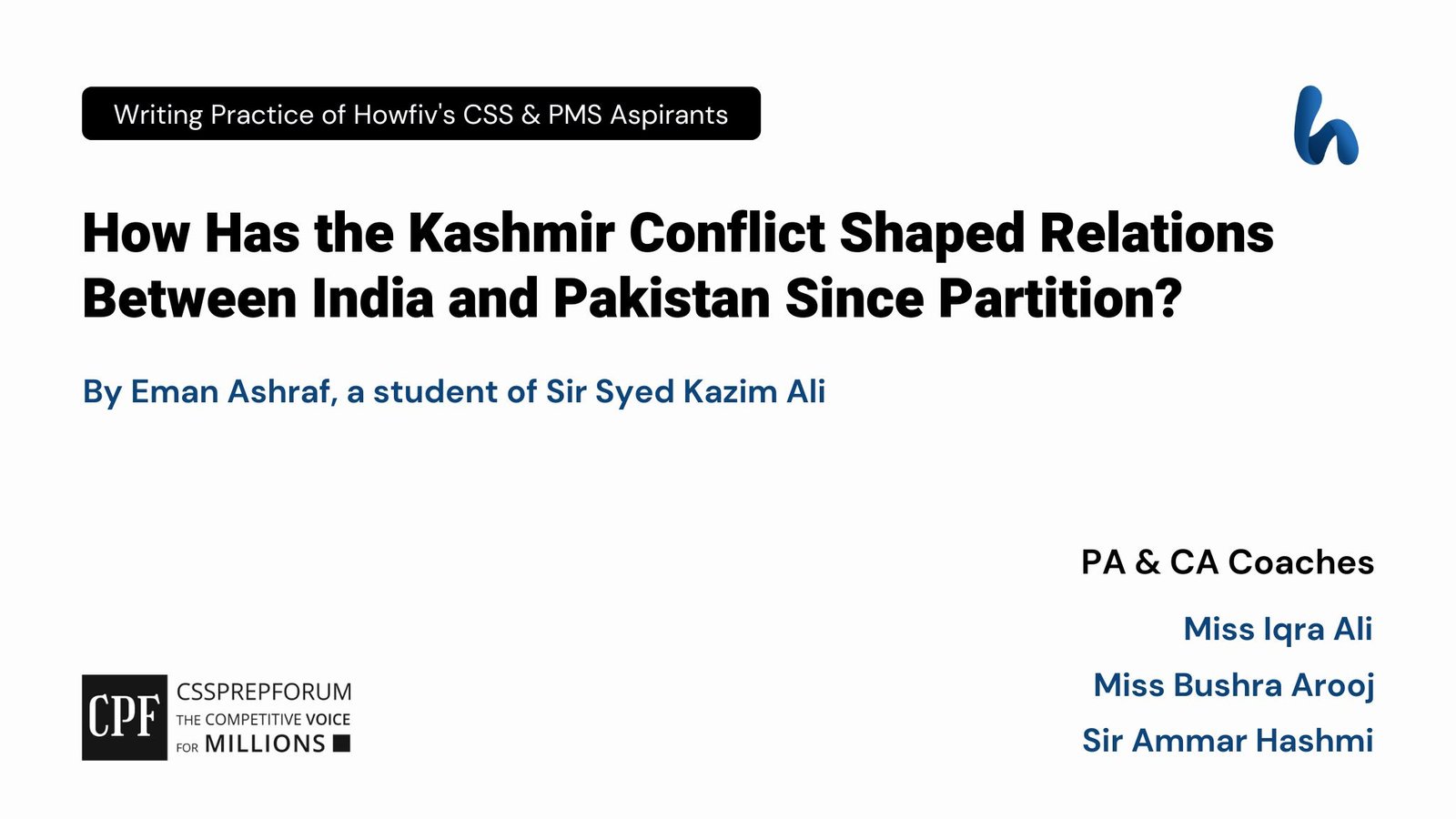CSS 2023 Solved Pakistan Affairs Past Papers | Having the largest irrigation system in the world, the land of the sub-continent served as the main food supply basket for the British power for more than a century, but now Pakistan has to import food commodities. Discuss in detail the causes of this agricultural decline.”
The following question of CSS Pakistan Affairs 2023 is solved by Miss Iqra Ali, Pakistan’s Best Pakistan Affairs Coach, on the guided pattern of Sir Syed Kazim Ali, which he taught to his students, scoring the highest marks in compulsory subjects for years. This solved past paper question is uploaded to help aspirants understand how to crack a topic or question, how to write relevantly, what coherence is, and how to include and connect ideas, opinions, and suggestions to score the maximum.

Question Breakdown
The following question sheds light on the agricultural decline in Pakistan despite having the largest irrigation system in the world. The following answer mentions the causes of the decline of agricultural issues along with measures that need to be taken to tackle the issues.
Outline
1- Introduction
2- Historical Overview of the agriculture sector in Pakistan
3- The current situation of the agriculture system in Pakistan
- The imports of food products in Fiscal Year 2023 amounting to $6 billion, according to the latest data issued by the State Bank of Pakistan
4- Causes for agricultural decline in Pakistan
- ✓ Administrative Causes
- Outdated irrigation infrastructure wasting the already scarce valuable resource- water- beyond limits
- Inept implementation of land and agricultural reform impeding the optimal land use
- ✓ Environmental Causes
- Vulnerability to climate change-induced disasters changing the natural crop cycle and destroying the already cultivated crops
- Scarcity and impurity of natural resources making fertile fields arid and useless
- ✓ Economic Causes
- Lack of investment in technology and education hindering the well-informed practices and decision-making of peasants
- Unequal distribution of resources depriving low riparian areas from the basic inputs of agriculture
- ✓ Political Causes
- Inefficient policies of the stakeholders making the farmers more dependent on imported catalysts of agricultural growth
- The exploitation of farmers in the hands of feudal lords leaving in marginalized peasants with no self-interest in increasing crop output
5- Measures that need to be taken to uplift the agricultural sector
- ✓To build consensus on the making of water bodies like dams
- ✓To take into serious consideration the land reforms
- ✓To focus on the adaptation through proper surveillance strategies to make good use of disaster-vulnerable land
- ✓To ensure the equal distribution of natural and economic resources
- ✓To ensure the investment in technology and education for the agrarian community
- ✓To grant subsidies to the local private seed and fertilizer companies
- ✓ To utilize mass media to make the peripheral farmers aware of the changing patterns
6- Conclusion

Answer to the Question
Introduction
Pakistan, like all other agrarian countries of the world, depends majorly on the agricultural sector for its survival and progress. Historically, the country’s part of the subcontinent had the largest irrigation system in the world, serving as the main food supply basket for the British power for more than a century. However, Pakistan now has to import food commodities because the sector, since the country’s inception, has not been given due importance at every level, with a few exceptions. Administratively, the inept implementation of land reforms and outdated irrigation practices; environmentally, vulnerability to climate-induced disasters and scarcity of natural resources; economically, lack of investment in technology and unequal distribution of resources; and politically, inefficient policies and feudal monopoly are the major culprits behind the agricultural downfall in the land of the pure. As a result, the sector with a high innate potential for productivity has badly failed to produce the desired outcome. Nonetheless, with hindsighted policies, such as making of dams, sagacious land reforms, proper surveillance strategies to make good use of disaster-vulnerable land, equal distribution of natural and economic resources, grant of subsidies for the local private seed and fertilizers companies, and the utilization of mass media to aware the peripheral farmers of the changing patterns, the agricultural contribution in the country’s economic development could be boosted at an unprecedented level.
Historical Overview of the agriculture sector in Pakistan
Historically, Pakistan’s land of the subcontinent, having the largest irrigation system in the world, served as the main food supply basket for British power for more than a century. However, after the partition, the country was left with limited opportunities and inept stakeholders, leading to the initial stagnant decade. Nonetheless, the green revolution of the Ayub regime played a positive role in Pakistan’s agricultural development. Similarly, as time passed, the sector faced various ups and downs, but no sustainable step has been taken, leading to the deterioration of the country’s natural resources in the long run. Now, the country, unfortunately, has become a major importer of food commodities.
The current situation of the agriculture system in Pakistan
Currently, Pakistan has regrettably transitioned into a significant food commodity importer due to the country’s agricultural crisis. According to the latest data issued by the State Bank of Pakistan, the imports of food products in the first six months in the Fiscal Year 2023 have surged dramatically, amounting to $6 billion. The pathetic reliance on imported food commodities underscores the challenges faced by the agricultural sector. Thus, addressing the issues linked with the disaster is imperative for Pakistan’s long-term food security and economic stability.
Causes for agricultural decline in Pakistan
- ✓ Administrative Causes
The prevailing challenges in Pakistan’s agricultural system are multi-faceted, with administrative causes playing a pivotal role in exacerbating the issues. Outdated irrigation infrastructure is a significant concern, causing an excessive and wasteful depletion of the already scarce water resources. In many cases, water storage bodies are nonexistent, dams are in dire need of development, and canal systems are in dire need of maintenance and modernization. The inefficient irrigation infrastructure not only leads to water wastage but also hinders the equitable distribution of this precious resource. Moreover, the inept implementation of land and agricultural reforms further compounds the problems. Land, which should be a vital asset for food production, often remains underutilized or misused. Unfortunately, valuable agrarian lands have been diverted for industrial and residential purposes, leaving only saline or less fertile land for crop cultivation. Thus, the shortsighted land-use policies have not only reduced agricultural productivity but also put immense pressure on the limited arable land available.
- ✓ Environmental Causes
Moreover, the impact of climate change-induced disasters has been a significant factor in damaging the agricultural productivity of the country. Gone are the days when Pakistan’s environmental conditions were conducive to robust agricultural growth. Now, changing natural crop cycles and the destruction of already cultivated crops have become more frequent occurrences, threatening food security. For instance, the erratic weather patterns and frequent flooding have disrupted agricultural activities, causing damage to crops and resulting in the displacement and loss of livelihoods. Furthermore, the scarcity and impurity of natural resources have made fertile fields arid and useless. It is particularly evident in the issues of waterlogging, salinity, and the broader water crisis. These problems have not only reduced the arable land available but have also impacted the quality of the soil and the viability of agriculture in many regions.
- ✓ Economic Causes
Moving further, economic factors present significant hurdles to the growth and sustainability of Pakistan’s agricultural sector. One key challenge is the lack of investment in technology and education, which hampers the ability of farmers to make well-informed decisions and implement best practices. The absence of knowledge on how to effectively deal with pests and utilize modern, water-efficient techniques like drip irrigation result in crop diseases and reduced yields. The knowledge gap leaves farmers vulnerable to preventable losses and underutilizes the potential of cutting-edge agricultural methods. Another critical economic issue is the unequal distribution of resources within the agricultural sector. In particular, the deprivation of low-riparian areas, as exemplified in almost all of Sindh, of basic agricultural inputs such as seeds, fertilizers, and water resources is a pressing concern. This unequal allocation of resources exacerbates regional disparities and impedes the development of agriculture in these marginalized areas.
- ✓ Political Causes
Last but not least, inefficient policies and the lack of political will among stakeholders have contributed to the sector’s dependency on imported catalysts for agricultural growth. Rather than nurturing self-sufficiency, reliance on external inputs limits the sector’s long-term sustainability. Without a political knowledge base to introduce policies promoting research and development (R&D) and technical training for farmers, innovative and modern farming practices are hindered. Not only has this, the exploitation of farmers at the hands of feudal lords, where a small fraction of landlords controls a vast majority of agricultural land, greatly contributed to the agricultural downfall. The unequal distribution of land ownership creates a system where marginalized peasants have little incentive to increase crop output or invest in sustainable agricultural practices, as they often face exploitative arrangements and lack the autonomy to make decisions that benefit their own livelihoods.
Measures that need to be taken to uplift the agricultural sector
As there is always a light at the end of the tunnel, with the following policies in hindsight, the agricultural contribution to Pakistan’s economic development could be boosted at an unprecedented level. First, there is a need to build consensus on making water bodies like dams, mainly the Kalabagh dam. Second, the land reforms must be taken into serious consideration. Third, there must be a focus on adaptation through proper surveillance strategies to make good use of disaster-vulnerable land. Fourth, the equal distribution of natural and economic resources must be ensured. Fifth, the agrarian community’s investment in technology and education must be increased. Sixth, subsidies must be granted to the local private seed and fertilizer companies. Last but not least, mass media must be utilized to make the peripheral aware of the changing patterns.
Conclusion
In conclusion, Pakistan’s agricultural sector, once a cornerstone of its economy, now grapples with multifaceted challenges, leading to heavy dependence on food imports due to mismanagement, outdated irrigation practices, inadequate land reforms, unequal resource distribution, and feudal monopoly over land. Therefore, measures such as consensus-building on water body construction, prioritizing land reforms, effective disaster-prone land surveillance, and mass media awareness campaigns are essential to restore the agricultural sector’s historical significance and ensure its economic prosperity and food security.
CSS 2023 Solved Pakistan Affairs
CSS Solved Past Papers’ Essays
Looking for the last ten years of CSS and PMS Solved Essays and want to know how Sir Kazim’s students write and score the highest marks in the essays’ papers? Then, click on the CSS Solved Essays to start reading them.
CSS Solved Essays
CSS Solved General Science & Ability Past Papers
Want to read the last ten years’ General Science & Ability Solved Past Papers to learn how to attempt them and to score high? Let’s click on the link below to read them all freely. All past papers have been solved by Pakistan’s top CSS GSA coach having the highest score of their students.
General Science & Ability Solved Past Papers












